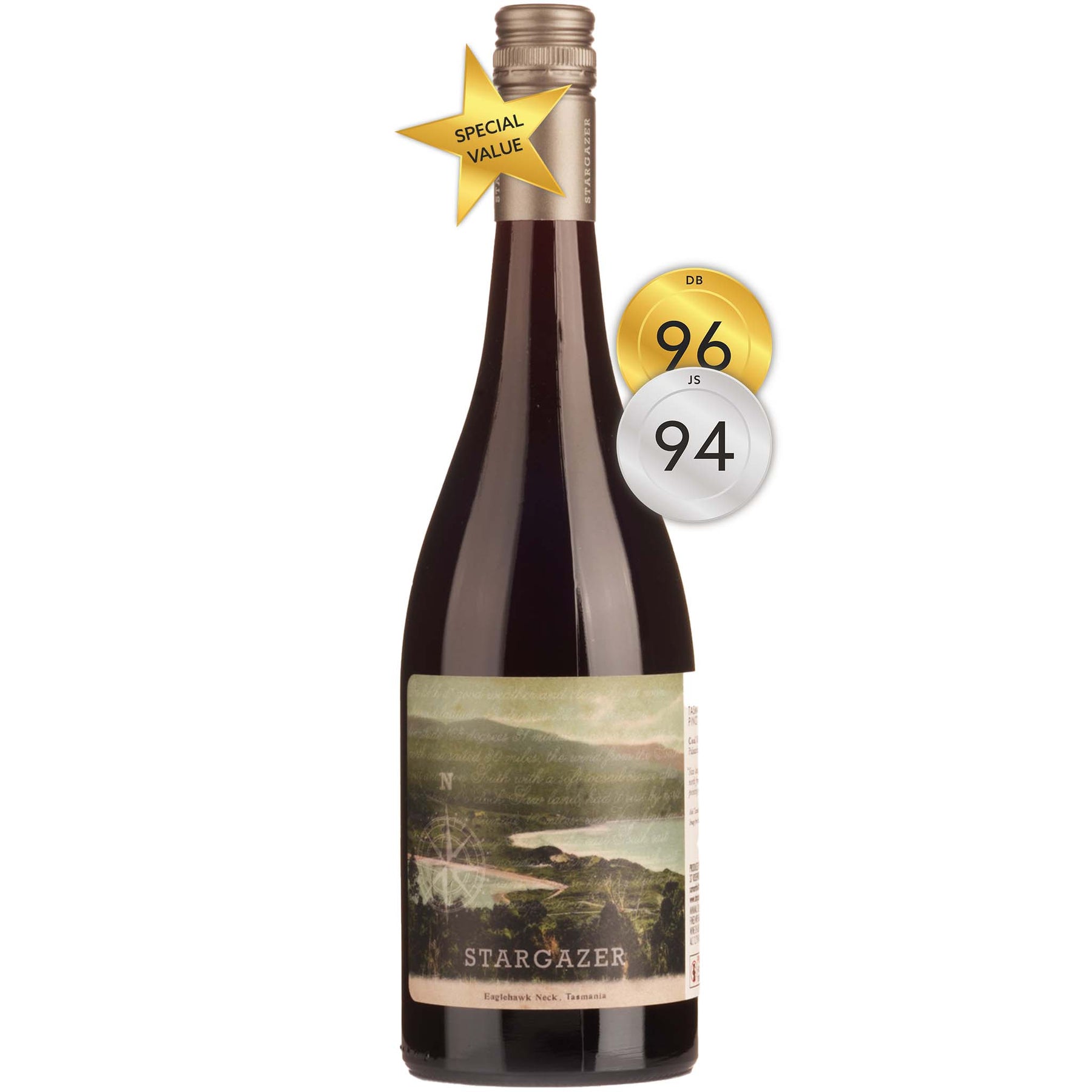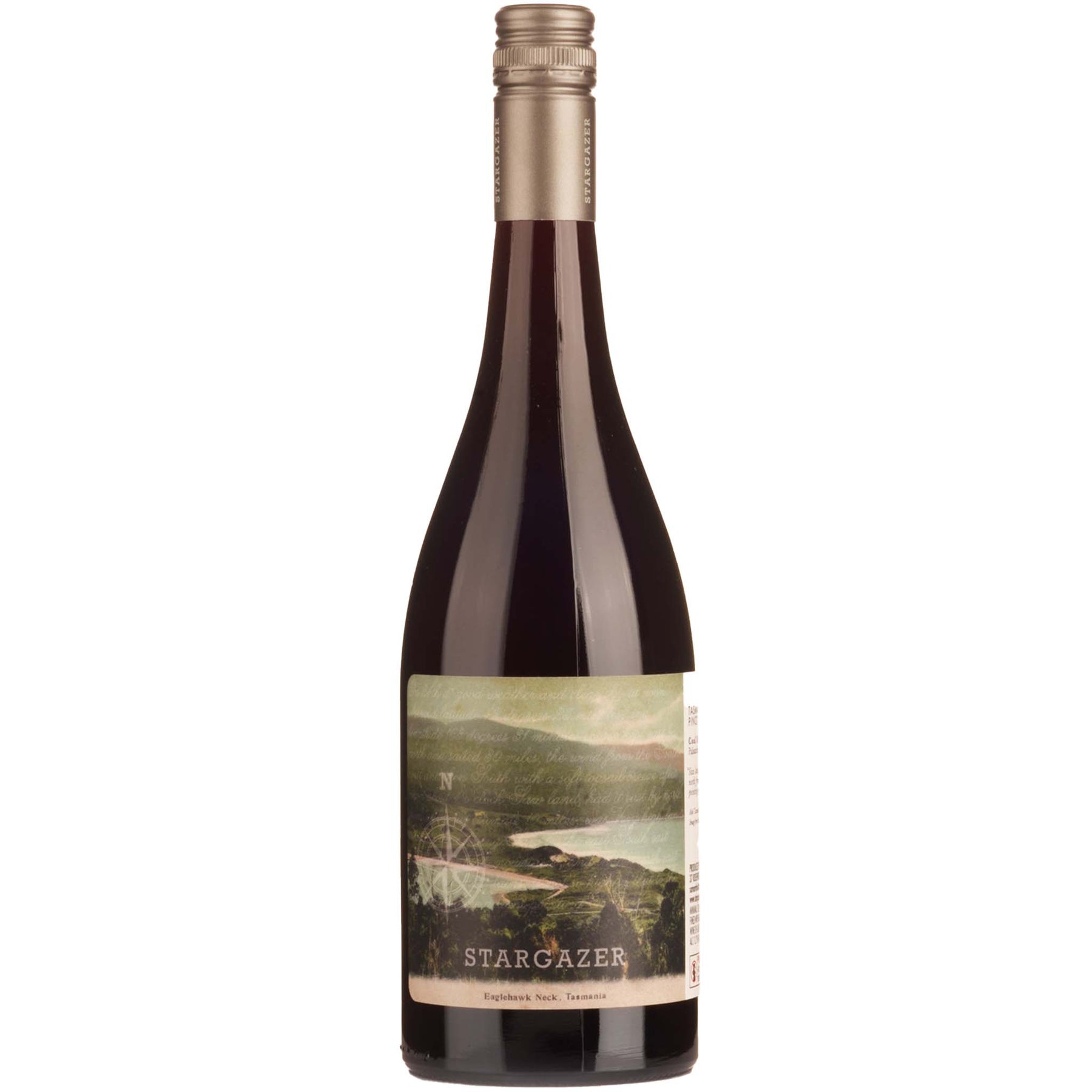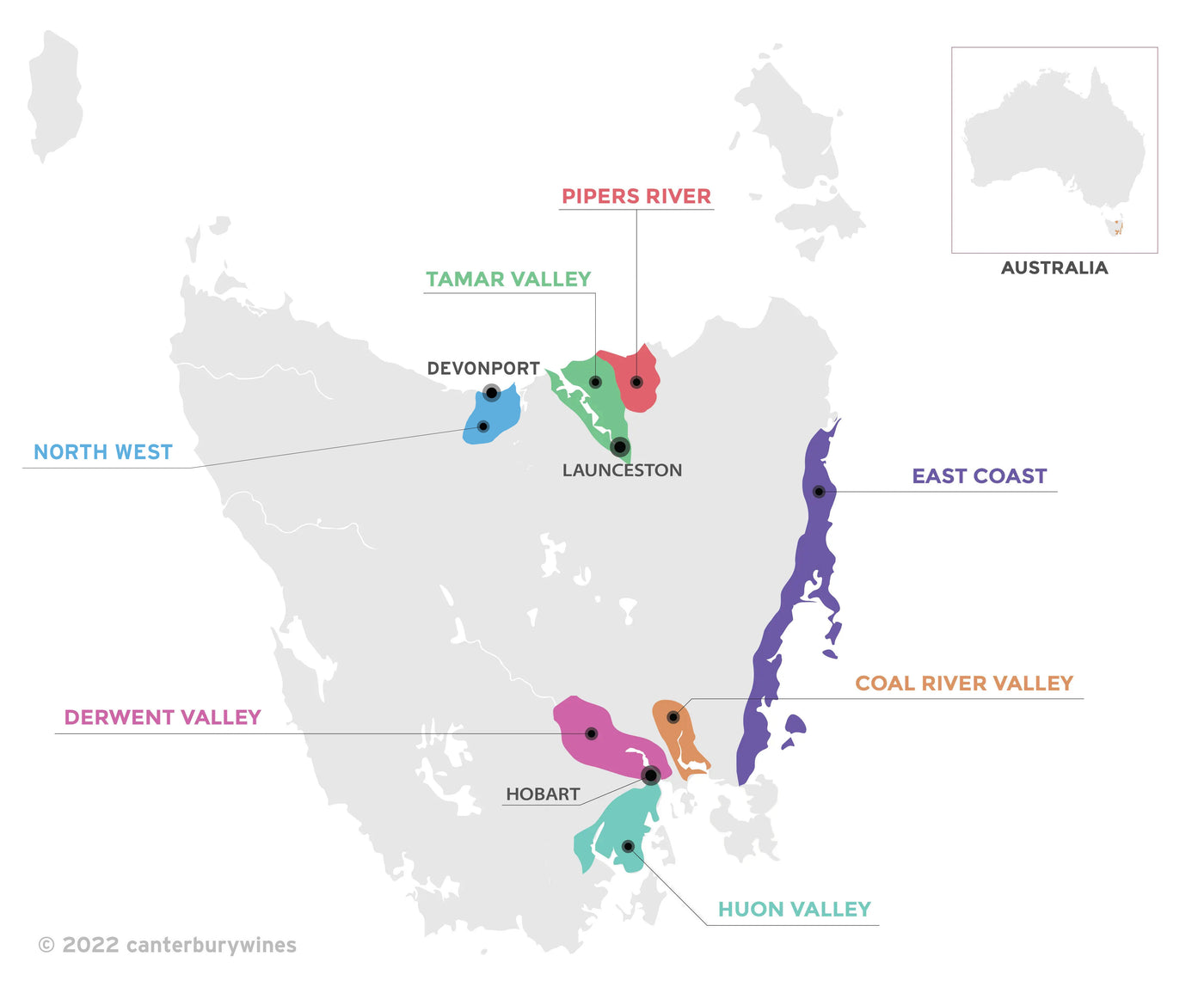

Stargazer Palisander Vineyard Pinot Noir 2023
Style: Red Wine
Closure: Screwcap
Stargazer Palisander Vineyard Pinot Noir 2023
Warehouse
34 Redland Drive
Vermont VIC 3133
Australia
Critic Score: 96
Alcohol: 13.0%
Size: 750 ml
Drink by: 2036
Internationally acclaimed winemaker and pinotphile Samantha Connew purchased the Palisander vineyard in the Coal River Valley in 2016. She promptly expanded the vineyard, planting more Pinot Noir to add to the original plantings of 2004, winning the Royal Agricultural Show Society’s Vineyard of the Year award in 2019.
"A beautifully pure, flint-struck Coal River Valley pinot noir from Sam Connew this year, perhaps showing a little more concentration than the previous release but losing none of the grace, detail and inherent drinkability that we love. Red fruits, wild strawberry and dark cherry fruits, five-spice, dried citrus rind, rose petals, hoisin, turned undergrowth and pressed wildflowers. Elegant and harmonious on the palate, that gunpowdery reduction working its way through the pure fruit like tendrils, lending complexity and interest. A saline, mineral cadence pushes the wine forwards to its end point, showing great length of flavour throughout." Dave Brookes
The 2023 Stargazer Pinot Noir is the eighth Pinot to come from the Palisander vineyard. It comprises 20% whole bunches and is a combination of 5 clones - Abel,115, 777, MV6 and G5V12. The grapes were hand-picked, wild fermented and matured in French oak barrels (25% of which were new) for 8 months prior to blending, then spent 10 weeks in tank before bottling.
"Bright ruby crimson in colour, the nose has a little meaty gunpowder reduction which opens up to reveal a lively combination of predominantly red fruits. Rosehip, sour cherry and pomegranate dominate, but there is some clove and green peppercorn spiciness there also. The palate is compact and tight, with real nerve and tension driving the layered tannins and supporting the generous fruit right through to the finish." Stargazer
Expert reviews
"A beautifully pure, flint-struck Coal River Valley pinot noir from Sam Connew this year, perhaps showing a little more concentration than the previous release but losing none of the grace, detail and inherent drinkability that we love. Red fruits, wild strawberry and dark cherry fruits, five-spice, dried citrus rind, rose petals, hoisin, turned undergrowth and pressed wildflowers. Elegant and harmonious on the palate, that gunpowdery reduction working its way through the pure fruit like tendrils, lending complexity and interest. A saline, mineral cadence pushes the wine forwards to its end point, showing great length of flavour throughout. Drink: 2024–2036." Dave Brookes, Halliday Wine Companion - 96 points and Special Value Wine ★
"Vibrant aromas of dark cherries, rhubarb, spices, cassia bark and red apple skin. The palate is medium-bodied with finely integrated tannins and bright acidity, giving notes of wild blackberries, graphite and violets. Nicely constructed with a savory undertone. Drink or hold. Screw cap." James Suckling, jamessuckling.com - 94 points
Awards
Special Value Wine – Halliday Wine Companion ★
Palisander vineyard
 The original 1ha Paliser vineyard, located at the northern end of the Coal River Valley, was planted by Norm and Jan Gangell in 2004 to both Pinot Noir and Riesling (pretty much half and half). It was purchased in 2016 by the current owner and winemaker, Samantha (Sam) Connew. In late 2017, Connew expanded the vineyard to include an additional two hectares of vines: more pinot noir (four clones), some chardonnay (another four clones) and more riesling. Stage two of the expansion was planted in October 2021: more pinot noir (two clones), gamay, pinot blanc, riesling, pinot gris and Gewurztraminer.
The original 1ha Paliser vineyard, located at the northern end of the Coal River Valley, was planted by Norm and Jan Gangell in 2004 to both Pinot Noir and Riesling (pretty much half and half). It was purchased in 2016 by the current owner and winemaker, Samantha (Sam) Connew. In late 2017, Connew expanded the vineyard to include an additional two hectares of vines: more pinot noir (four clones), some chardonnay (another four clones) and more riesling. Stage two of the expansion was planted in October 2021: more pinot noir (two clones), gamay, pinot blanc, riesling, pinot gris and Gewurztraminer.
Palisander Vineyard is located on brown dermosol soil over jurassic dolerite, the igneous rock which gives over half of Tasmania its distinctive geological formations (think the rocky outcrops on the Tasman Peninsula). The soil is particularly high in calcium which is a positive indicator for quality grapes, being associated with thicker skins and slower ripening. Connew and vineyard manager Bryn Williams (succeeded by Guy Young) are fervent believers in sustainable farming, biodiversity and regenerative agriculture. Sheep are used in the vineyard during winter for weed control, chickens free range throughout the year and scratch around for bugs, bees contribute their pollination magic (and honey) and, since 2020, over 1000 native species have been planted on the property.
The following article is reproduced from: https://younggunofwine.com/vineyard/stargazer-palisander-vineyard-tasmania/
Palisander vineyard, in Tasmania’s Coal River Valley, was originally planted with 1-hectare of pinot noir and riesling vines in 2004, and later purchased by Samantha Connew – the talented winemaker behind the Stargazer label. Since then, Connew expanded the plantings to 5-hectares with the addition of chardonnay, gamay, pinot blanc, pinot gris, and gewurztraminer. The viticulture is managed by Bryn Williams with a holistic approach rather than simply a grape monoculture – providing economic sustainability as well as biodiversity. Palisander stands out for its depth of pinot noir and chardonnay clones, and unique focus on producing Alsatian blends.
Connew and Williams have adopted a holistic approach to viticulture, emphasizing not just the cultivation of high-quality grapes but also the fostering of biodiversity and economic sustainability within the vineyard. By integrating a variety of plant species and sustainable farming practices, Palisander transcends the typical grape monoculture, contributing to a richer, more resilient ecosystem. This forward-thinking strategy ensures that the vineyard not only produces exceptional wines but also supports the environmental health of the region, embodying a true commitment to both the land and the legacy of Tasmanian wine.
Samantha Connew, the visionary behind Palisander Vineyard, offers insightful reflections on how her vineyard’s unique location within the Coal River Valley contributes to its distinct wine profile. Comparing the site of Palisander to other vineyards in the region, Connew says: "In terms of the broader region, our vineyard probably has a slightly bigger diurnal temperature range than others. We tend to be a little bit cooler overnight than others and we are certainly one of the later sites in the Coal River Valley so have some extra time for flavour development."
Expanding her insights to encompass the wider Tasmanian wine landscape, Connew highlights the distinctive viticultural attributes of the Coal River Valley compared to other Tasmanian (unofficial) sub-regions: "Riesling, chardonnay and pinot noir are all ideally suited to the Coal River Valley and particularly this little sub region of Tea Tree. We have really high calcium levels in our soils which helps with soil moisture-holding capacity as well as disease resistance. Calcium is a building block of strong cell walls and mainly found in grape skins, which I think is one of the reasons we have such thick skins in our Riesling. We also have quite a different acid structure in our whites; whilst our pHs are low, our TAs are not super high and the acid is more sherbetty and tangy rather than linear and piercing, resulting in the wines being more approachable when young."
Delving into the winemaking process, Connew elaborates on how the distinctive characteristics of riesling grapes from Palisander Vineyard are enhanced through specific vinification techniques. She illustrates how the unique skin attributes of the riesling grown translate to winemaking decisions: "The riesling is also from the older section of the vineyard and is wild fermented in ceramic and concrete eggs following up to 12 hours skin contact. The decision to use skin contact was made after several years of tasting the fruit and observing the impact of the thicker skins both on disease resistance but also the flavour in the skins. This is encouraged by early season shoot thinning and exposing the bunches to sun as well as lateral thinning later in the season. The resultant wine demonstrates the impact of positive phenolics in riesling, a very different perspective to how most winemakers make this variety in Tasmania."
Overseeing the viticulture, Bryn Williams collaborates with Connew to enhance the overall working environment, which connects to their philosophy of 'sustainability'. "The focus as a small business has been on nothing going to waste, so many of our projects are about efficiency and financial sustainability which has in turn led to increased environmental and social sustainability as well. An example of the latter is investing a significant amount of time in encouraging a range of different activities on site which all contribute to our biodiversity, but which also break up the monotony of grape growing and make the vineyard a more enjoyable place to work."
Williams expands on these activities: "We treat the vineyard in a more holistic fashion as a farm rather than simply a grape monoculture. In addition to the olives and native vegetation corridors, we also have an orchard of nut and fruit trees and have recently planted a range of berries. We have two bee hives, some free-range chickens and sheep who graze the vineyard in winter, as well as a worm farm from which we hope to use the worm tea in the vineyard this year."
But there’s a bigger picture and a longer term view that drives William, too. "Our philosophy is very much based on leaving our plot of land better than we found it, " he says. "So we have done an extensive amount of work with Landcare supported both with grants from them and with our financial and time investment in establishing three native vegetation corridors (comprising over 1000 plants) with another one planned for the spring of 2024. These areas are all thriving and providing a home for the beneficial insect populations we are trying to encourage."
Williams drills down to the efforts focused on the soil health. "All green waste and grape marc are retained to be used in our compost program which is then spread under vine in either spring or autumn, and rather than simply creating burn piles of olives trees from a grove which was removed to plant extra vineyard, the trees were transplanted to an additional area deemed too marginal for vines. The olive oil produced is used as gifts for Stargazer wine club members."
This management has paid off tangibly in the vineyard, as Williams shows: "Our site management plan requires us to do soil tests each year. Pleasingly, since 2016 when we took over the site, we have been able to increase organic carbon levels from 3.5% to 4.3% in the most recent test."
Williams describes their response to climate change: "Whilst Tasmania has been relatively insulated from the impacts of climate change, we are certainly aware of what is on the horizon. For this reason, we have planted a broad range of different chardonnay and pinot clones in the new blocks as an insurance policy and also have a range of different exposures and row orientations for all of our different management units."
"Everything is a slow burn on a vineyard level; it all happens on a level of incremental knowledge rather than a single lightbulb moment."
About the winery

Samantha Connew in the Palisander vineyard
Samantha (Sam) Connew is the owner and winemaker of Stargazer, a boutique winery located in the Coal River Valley in southeast Tasmania. The former Kiwi discovered wine while working part-time at a wine bar after finishing a double degree in Arts and Law at Christchurch University. Switching career paths, Sam took on a postgraduate Diploma of Viticulture and Oenology and worked her first vintage in 1996 at Elk Cove in Oregon and fell in love with Pinot Noir. After subsequent vintages in Australia, Italy, Spain and Oregon for a second time, Sam spent ten years as Senior Winemaker at Wirra Wirra in McLaren Vale and two years at Tower Estate in the Hunter Valley.
Sam's stint in the Hunter Valley changed her life. "Tower Estate began buying fruit from Tasmania, so I started travelling backwards and forwards down there, spending time in vineyards," Connew recalls. "I remember thinking, whoa, the fruit here is awesome. Pretty soon, I began mulling over possibilities of living the Pinot dream."
In late 2011, Sam quit her job at Tower Estate and worked the 2012 vintage at Bay of Fires in Northern Tasmania alongside a fellow pinotphile winemaker, Peter Dredge. "Dredgy not only gave me a job, he suggested I buy fruit and make some wine for myself. I purchased 1.6 tonnes of Pinot Noir from Panorama Vineyard in the Huon Valley. With that, Stargazer was born." The emotive name is in part a tribute to Abel Tasman, the first European to sight Tasmania before proceeding to the South Island of NZ, navigating by the stars.
Connew made four successive vintages of Stargazer wine with fruit purchased from the Derwent Valley and Huon Valley while biding time in the Hunter Valley. However, she passionately believed that the Coal River Valley was the ideal subregion to grow Pinot Noir, Chardonnay and Riesling, and in 2016 purchased an 11ha property at Tea Tree, 30km north of Hobart, and moved to Tasmania. The property contained a 1ha vineyard planted to Pinot Noir and Riesling in 2004, which she named Palisander.
In late 2017, Connew expanded the vineyard to include an additional two hectares of vines: more pinot noir (four clones), some chardonnay (another four clones) and more riesling. Stage two of the expansion was planted in October 2021: more pinot noir (two clones), gamay, pinot blanc, riesling, pinot gris and gewurztraminer.
In May 2019, she celebrated three years of residence in Tasmania by winning the Royal Agricultural Show Society’s Vineyard of the Year award. "It was such a surprise but a real validation of all the hard work I’d put into following my dream," Connew says. "I’m really passionate about producing great Pinot Noir, Chardonnay and Riesling. Tasmania is the only place in Australia that can do really well with all three varieties. It’s become the perfect home for me."

Tasmania
Tasmania is a small island located below mainland Australia. It produces less than 1% of Australia’s wine but enjoys a global reputation as a leading producer of premium cool climate wines. It is prized for its top-class sparkling wine, Pinot Noir, Chardonnay and Riesling.
Tasmania is home to more than 230 wineries across 7 wine regions*. The reigions Coal River Valley, East Coast, Pipers River and Tamar Valley produce around 90% of Tasmania's wine, while the other three regions Derwent Valley, Huon Valley and North West produce the remaining 10%. * Please note these 7 wine areas are considered here to be subregions of Tasmania to aid site navigation.
Tasmania is the coldest wine State in Australia. Its climate is temperate, with a distinct maritime influence from the Tasman Sea to the east, Bass Strait to the north and the Indian Ocean to the west. Summer days are temperate while winter sees some of the coldest temperatures in Australia. It's unique climate and soils combine to create ideal growing conditions for cool-climate grape varieties.

